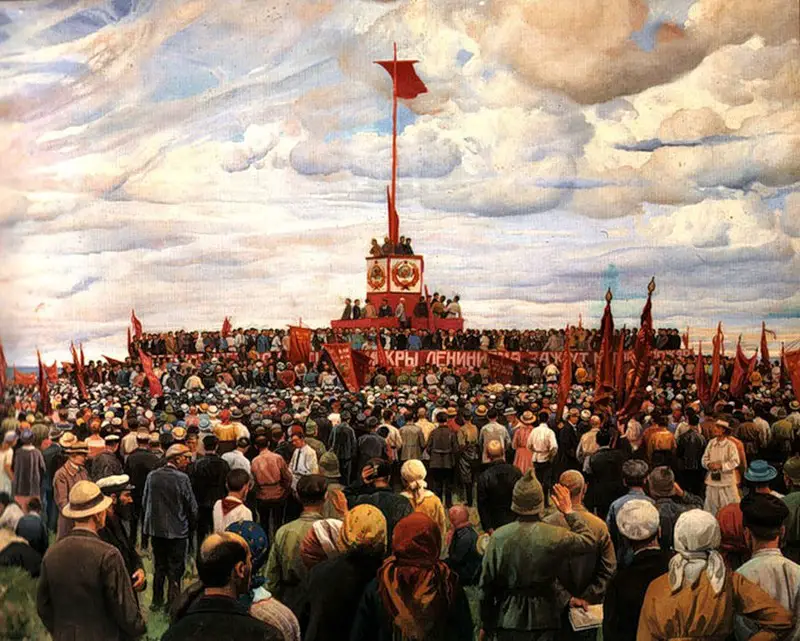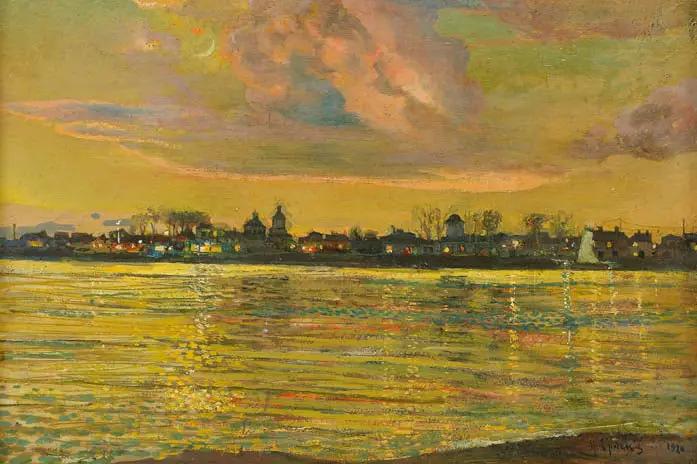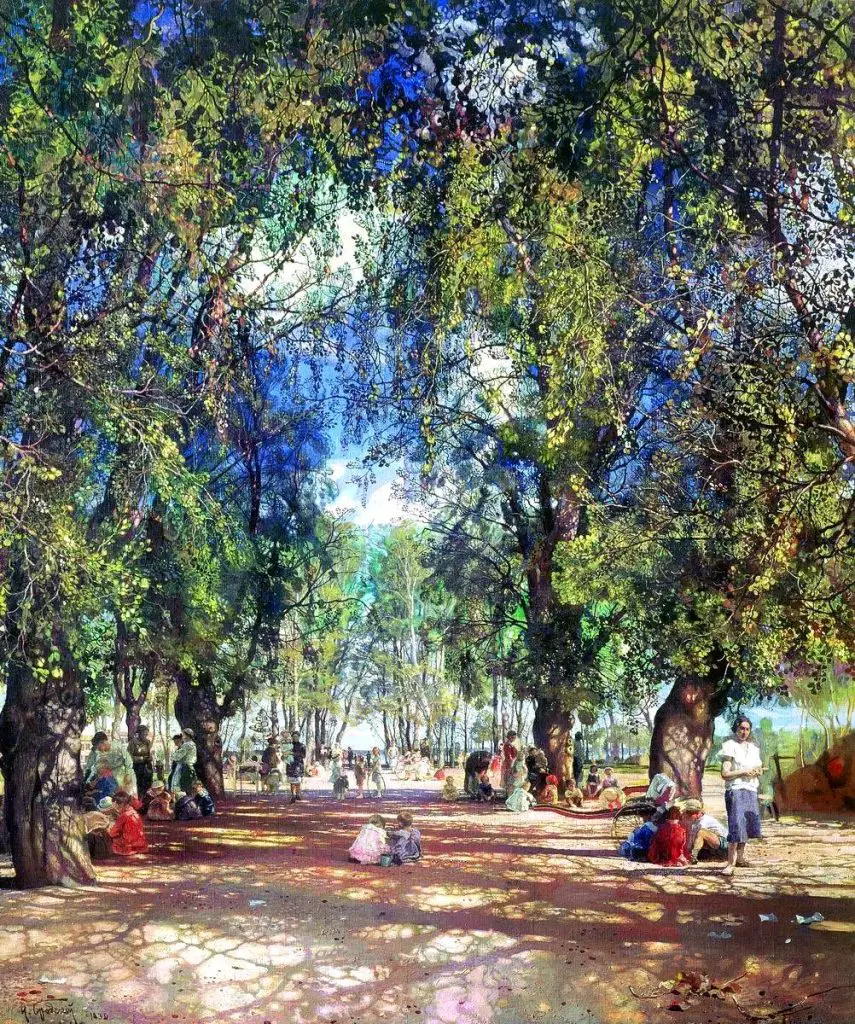Isaak Izrailevich Brodsky (Исаак Израилевич Бродский) was a Soviet painter whose work is especially notable for its role in the formation of the socialist realism art movement and for his works depicting Lenin. His paintings capturing events of the Russian Civil War and the Bolshevik Revolution are also notable.
Brodsky was born on January 6, 1884 (by the current calendar and on 25 December 1883 by the old calendar), in Sofiyivka, Ukraine, then part of the Russian Empire. Brodsky’s family was Jewish, his father a merchant and landowner. His younger sister became a musician.

Alexander III, who ruled Russia at the time, was a conservative ruler whose political ideal was a nation with a single nationality, language, religion and government. Part of his efforts to realize this goal included the persecution of Jews, including the enactment of the 1882 “May Laws,” which curtailed the activities of Jews and lasted for over thirty years. As he was a child growing up in a small town outside the main concentrations of population, the laws impacted the general cultural attitudes that Brodsky faced more than they imposed specific barriers in his day-to-day experiences.
In 1896, Brodsky graduated from the Berdyansk Municipal School and entered the Odessa Art School. For the first three years that he was there, the school was not a private art school, but an open Society of Fine Arts which maintained itself through wealthy patrons. On December 30, 1899, the school’s charter was approved and it became an art school. Brodsky continued to study at the school until 1902.

In 1902, Brodsky moved to St. Petersburg and began studies at the Imperial Academy of Arts, now the Russian Academy of Arts. Competition to attend the academy was fierce, especially for Brodsky. Under the May Laws, high schools and universities within the bounds of St. Petersburg and Moscow maintained admission limits for Jews at 3%. Training at the academy was virtually required for artists to make successful careers, as it fostered connections both between students and with mentors, and sent promising students abroad for further study as well as developing basic professional and technical skills. Brodsky studied at the academy for five years.
During 1909-1911, Brodsky used academy funding to travel through Germany, France, Spain, and Italy. He spent much of this time on the island of Capri, Italy, where there was a popular resort for European artists and writers during the late 19th century. Brodsky visited this resort after its heyday, although it was still a popular resort and a place to connect with other artists and writers. While there, he met and developed an acquaintanceship with writer Maxim Gorky, a political activist and founder of the socialist realism. Gorky, who supported communism and was arrested many times for opposing the Tsarist regime, spent time on Capri both for health reasons and for the opportunity to escape the increasing repression in Russia. Gorky was a personal friend of Lenin, who visited him on Capri in 1908.

Between the time Brodsky finished his travels and the start of the October Revolution in 1917, he participated in a series of exhibitions at the Academy of Arts and was an exhibitor for the “Comradeship of South-Russian Artists” (Товарищества южнорусских художников), “The Association of Traveling Art Exhibitions” (Товарищества передвижных художественных выставок), the A. I. Kuindzhi Society (Общества им. А. И. Куинджи) and the Community of Artists (Общины художников). He also joined the Jewish Society for the Encouragement of the Arts in 1916. In the summer of 1917, Brodsky began painting a portrait of Alexander Kerensky, who served as the second Minister-Chairman of the Russian Provisional Government between July and November 1917. He stopped working on Kerensky’s portrait after the October Revolution, instead painting portraits of Bolshevik leaders. He completed the painting of Kerensky in 1918.
Over time, Brodsky painted Soviet leaders including Vladimir Lenin; Joseph Stalin; Anatoly Lunacharsky, the first Soviet People’s Commissar of Education; Kliment Voroshilov, one of the original five Marshals of the Soviet Union; and Grigory Zinoviev, one of the seven members of the first Politburo.
Brodsky involved himself in the reorganization of art education in the USSR, earning the title of professor in 1932 and Director of the Russian Academy of Arts, formerly the Imperial Academy of Arts, in 1934. He enjoyed a good relationship with many leading painters, including his mentor, Ilya Repin, after whom the academy was later renamed. Brodsky used his connections to attract the greatest artists and teachers available to the academy and became a major figure in the art world of Soviet Russia. He used his influence to spread the socialist realism movement.
As an artist, Brodsky created a body of work that told the story of the Russian Civil War and the Bolshevik Revolution while adhering to the requirements of socialist realism. As an avid art collector, he built a legacy collection that led his apartment in Arts Square in St. Petersburg to be declared a national museum after Brodsky died. The collection contains many works by Russian artists from the 18th-early 20th centuries. For the parts of the collection that span the 1910s and 1920s, many of the works were created by authors with whom Brodsky personally participated in art exhibitions. Brodsky’s collection features major artists including Ilya Repin, Vasily Surikov, Valentin Serov, Isaak Levitan, Mikhail Vrubel and Boris Kustodiev.

Although socialist realism was the USSR’s official art form, Brodsky nevertheless worked to support more diverse varieties of work, and the museum showcasing his collection after his death became one of the few places where it was possible to see works of the avant-garde. Over the course of his life, Brodsky collected over a thousand works. He donated numerous paintings to his native Ukraine, and another museum was opened in his name in the city of Berdiansk.
Brodsky died on 14 August 1939 in Leningrad at 55 years of age. By this time, he was influential in the art world of Soviet Russia and with students including well-known Soviet artists Nikolai Timov, Alexander Laktionov, Yuri Neprintsev, Piotr Belousov, Piort Vasiliev and Mikhail Kozell. Brodsky’s rich life as a teacher, significant artist and ambassador of the arts lives on through the exhibition of his massive collection housed in his converted apartment, now the museum in St. Petersburg.

This entry was written by Helen Herring.







